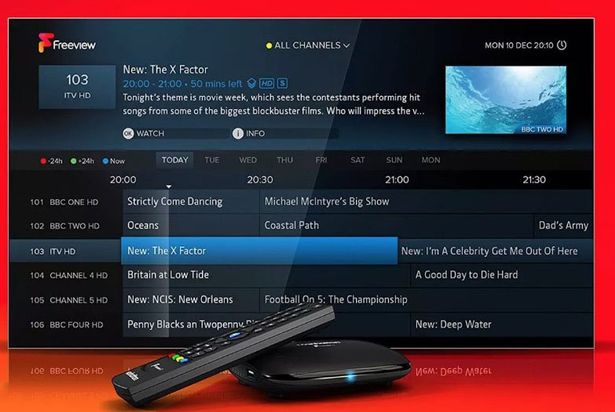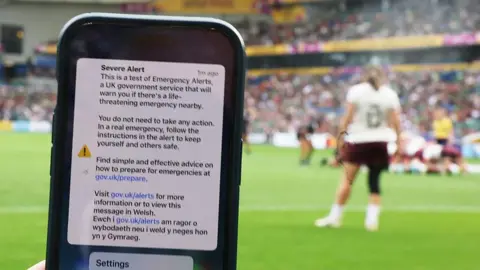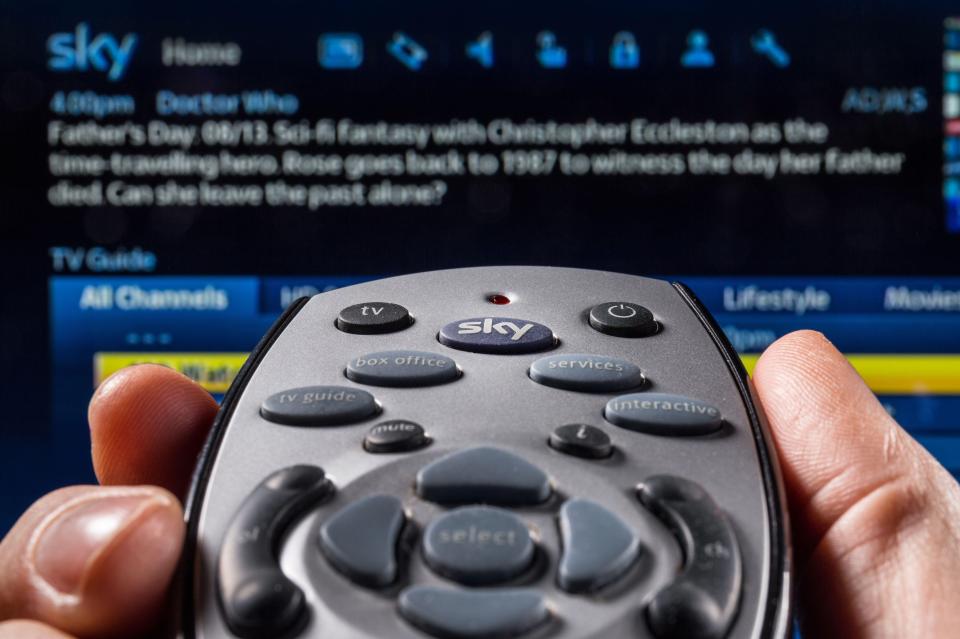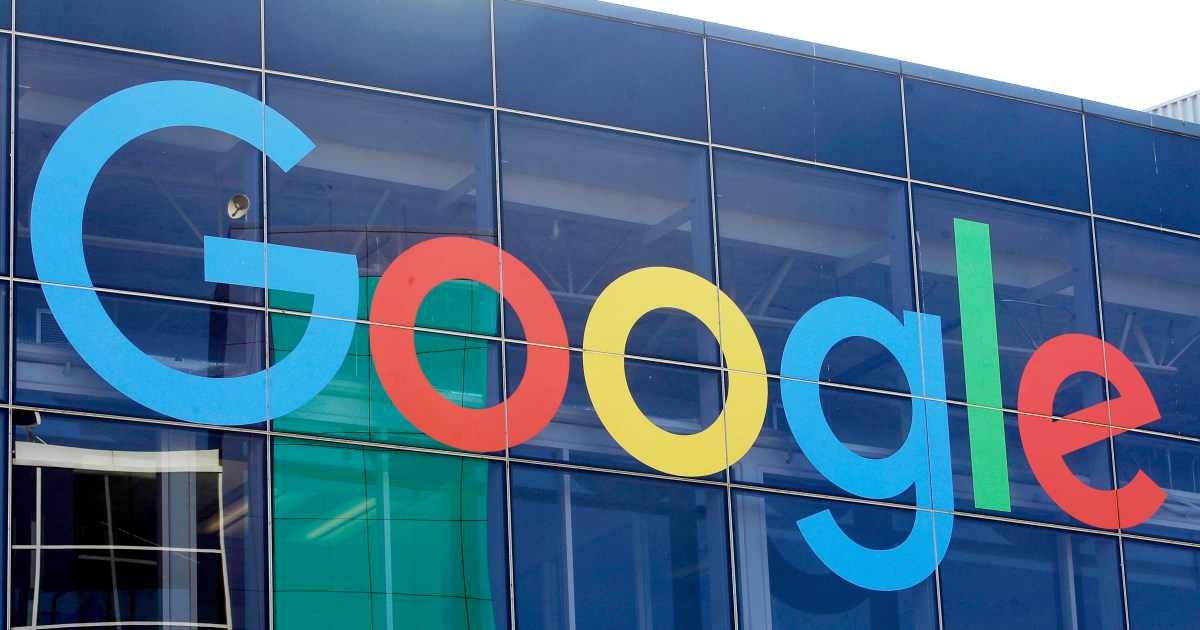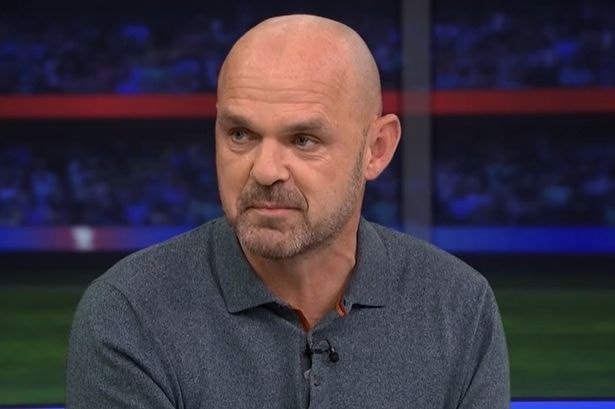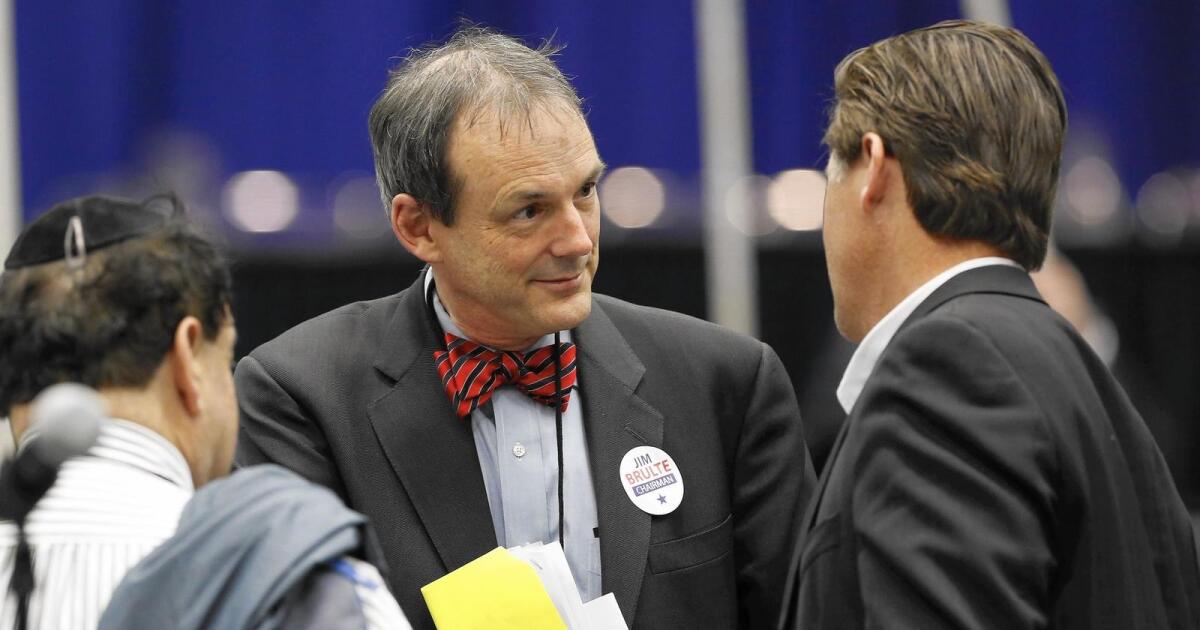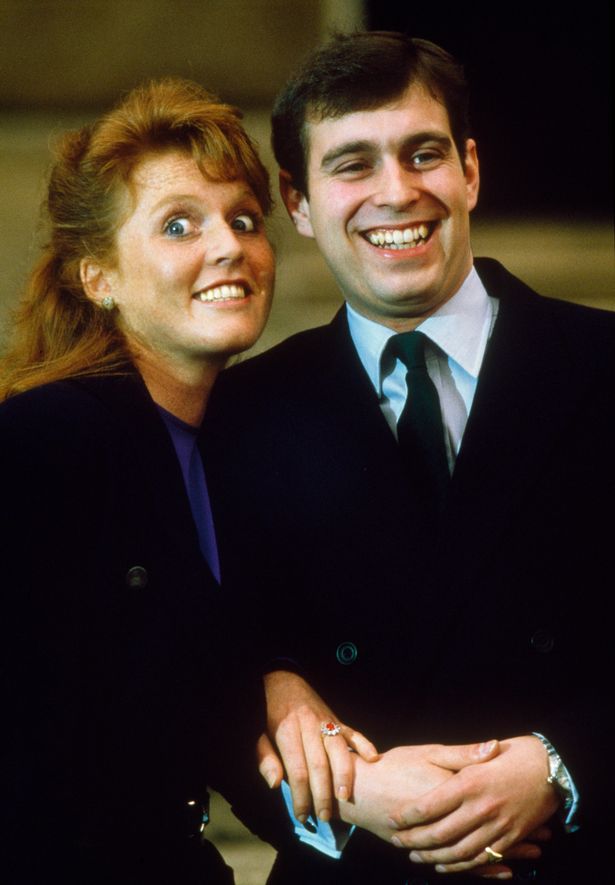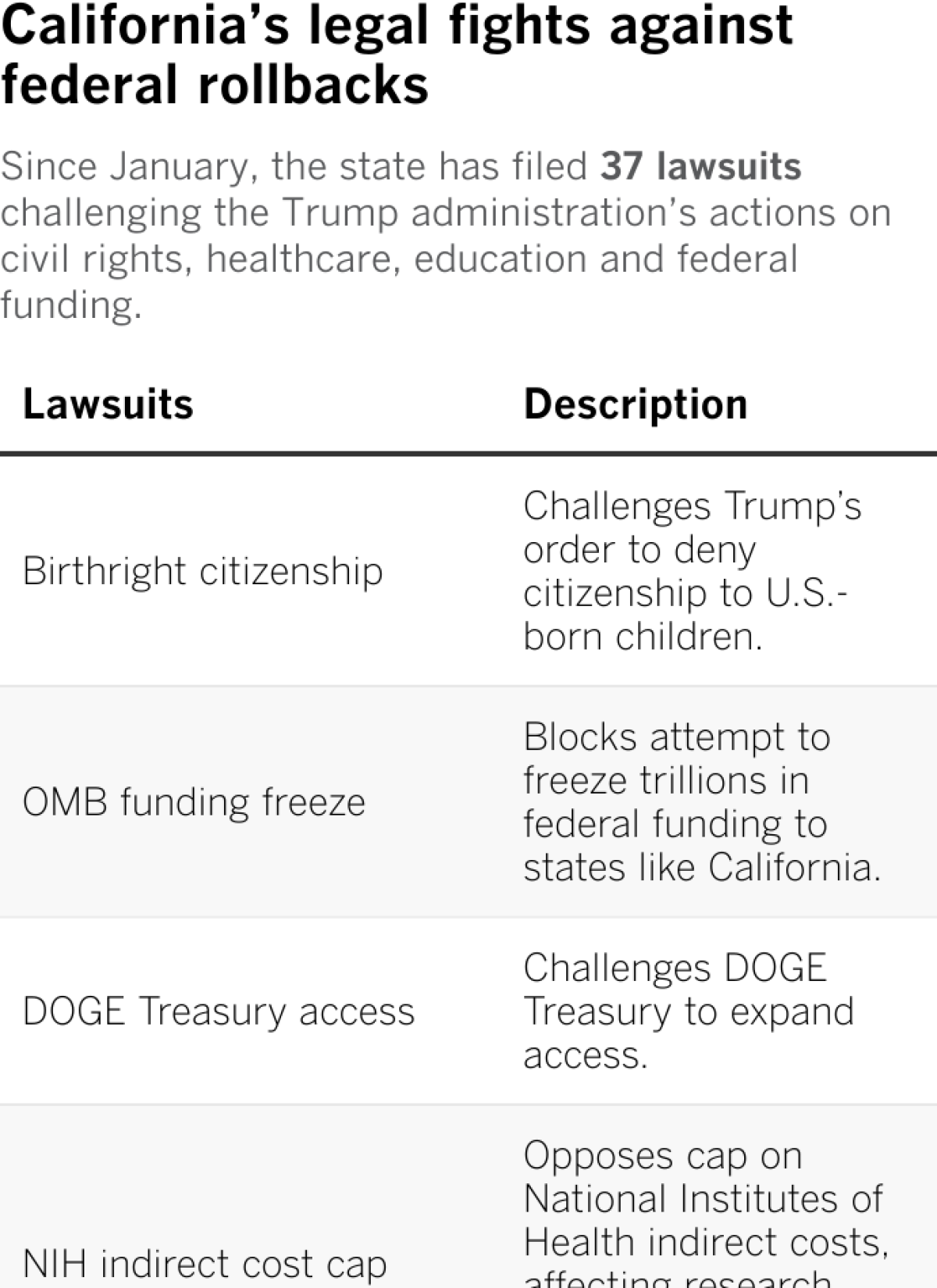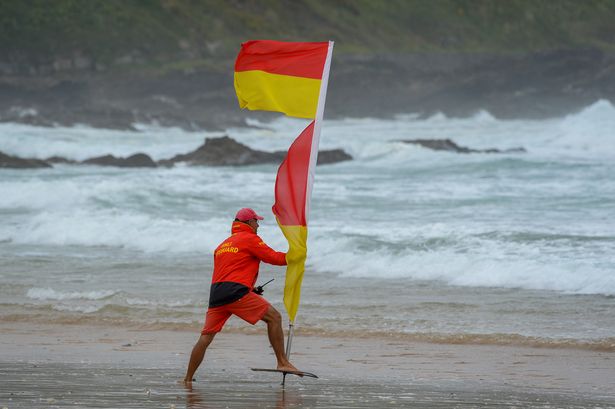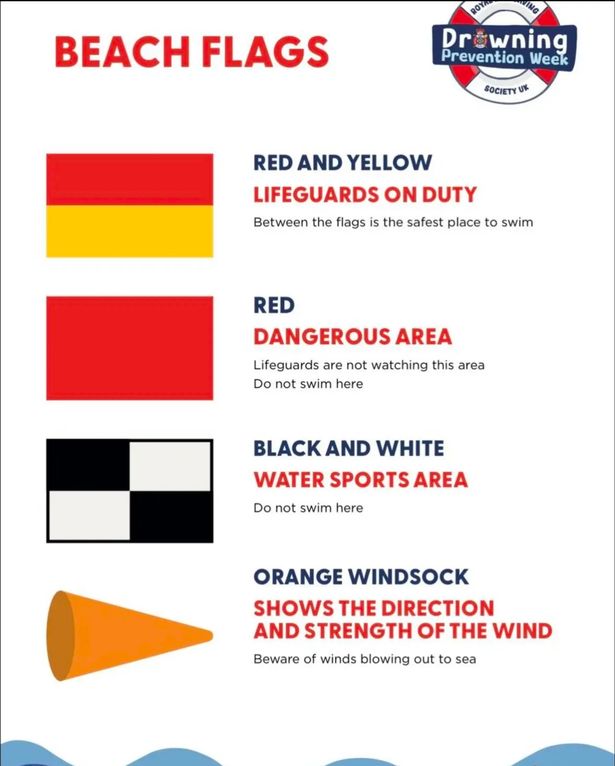University of California leaders face a difficult choice after the U.S. Department of Justice said this week that UCLA had violated the civil rights of Jewish students during pro-Palestinian protests and federal agencies on Wednesday suspended more than $300 million in research grants to the school.
Do they agree to a costly settlement, potentially incurring the anger of taxpayers, politicians and campus communities in a deep-blue state that’s largely opposed to President Trump and his battle to remake higher education?
Or do they go to court, entering a protracted legal fight and possibly inviting further debilitating federal actions against the nation’s premier public university system, which has until now carefully avoided head-on conflicts with the White House?
Leaders of the University of California, including its systemwide president, James B. Milliken; UCLA Chancellor Julio Frenk and UC’s 24-member Board of Regents — California Gov. Gavin Newsom is an ex-officio member — have just days to decide.
What led to the conflict
In findings issued Tuesday, U.S. Atty. Gen. Pam Bondi and the Justice Department said UCLA would pay a “heavy price” for acting with “deliberate indifference” to the civil rights of Jewish and Israeli students who complained of antisemitic incidents since Oct. 7, 2023. That’s when Hamas attacked Israel, which led to Israel’s war in Gaza and the pro-Palestinian student encampment on Royce Quad.
The Justice Department gave UC — which oversees federal legal matters for UCLA and nine other campuses — a week to respond to the allegations of antisemitism. It wrote that “unless there is reasonable certainty that we can reach an agreement” to “ensure that the hostile environment is eliminated and reasonable steps are taken to prevent its recurrence,” the department would sue by Sept. 2.
A day after the Justice Department disclosed its findings, the National Institutes of Health, National Science Foundation, Department of Energy and other federal agencies said they were suspending hundreds of grants to UCLA researchers. A letter from the NSF cited the university’s alleged “discrimination” in admissions and failure to “promote a research environment free of antisemitism.” A Department of Energy letter cutting off grants on clean energy and nuclear power plants made similar accusations, adding that “UCLA discriminates against and endangers women by allowing men in women’s sports and private women-only spaces.”
Initial data shared with The Times on Thursday night showed the cuts to be at least $200 million. On Friday, additional information shared by UC and federal officials pointed to the number being greater than $300 million — more than a quarter of UCLA’s $1.1 billion in annual federal funding and contracts. UCLA has not released a total number.
In a campuswide message Thursday, Frenk, the UCLA chancellor, called the government’s moves “deeply disappointing.”
“This far-reaching penalty of defunding life-saving research does nothing to address any alleged discrimination,” Frenk said.
In a statement to The Times Friday, an official from the Department of Health and Human Services, which oversees the NIH, said it would “not fund institutions that promote antisemitism. We will use every tool we have to ensure institutions follow the law.”
An NSF spokesperson also confirmed the UCLA cuts, saying Friday that the university is no longer in “alignment with current NSF priorities.” A Department of Energy spokesperson also verified the cuts but did not elaborate outside of pointing to the department’s letter to UCLA.
What comes next
The Times spoke to more than a dozen current and former senior UC leaders in addition to higher education experts about the rapid deliberations taking place this week, which for the first time have drawn a major public university system into the orbit of a White House that has largely focused its ire on Ivy League schools.
Trump has accused universities of being too liberal, illegally recruiting for diversity in ways that hurt white and Asian American students and faculty, and being overly tolerant of pro-Palestinian students who he labels as antisemites aligned with Hamas.
Universities, including UCLA, have largely denied the accusations, although school officials have admitted that they under-delivered in responding to Jewish student concerns. In the last two years, encampments took over small portions of campuses, and, as a result, were blamed for denying campus access to pro-Israel Jews.
In a major payout announced Tuesday — before the Justice Department’s findings — UCLA said it would dole out $6.45 million to settle a federal lawsuit brought by three Jewish students and a medical school professor who alleged the university violated their civil rights and enabled antisemitism during the pro-Palestinian encampment in 2024. About $2.3 million will be donated to eight groups that work with Jewish communities, including the Anti-Defamation League, Chabad and Hillel. Another $320,000 will be directed to a UCLA initiative to combat antisemitism, and the rest of the funds will go toward legal fees.
Through spokespersons, Frenk and Milliken declined interviews on what next steps UCLA might take. Friday was Milliken’s first day on the job after the long-planned departure of former UC President Michael V. Drake, who will return to teaching and research.
But in public remarks this week, Newsom said he was “reviewing” the Justice Department’s findings and that UC would be “responsive.”
The governor, who spoke during an event at the former McClellan Air Force Base in Sacramento County on Thursday, said he had a meeting with Drake scheduled that day to discuss the Trump administration’s charges.
Newsom did not respond specifically to a question from The Times about whether UC would settle with Trump.
“We’re reviewing the details of the DOJ’s latest and then that deadline on Tuesday,” the governor said. “So we’ll be responsive.”
In a statement Friday, Newsom said, “Freezing critical research funding for UCLA — dollars that were going to study invasive diseases, cure cancer, and build new defense technologies — makes our country less safe. It is a cruel manipulation to use Jewish students’ real concerns about antisemitism on campus as an excuse to cut millions of dollars in grants that were being used to make all Americans safer and healthier.”
What insiders say
Senior UCLA and UC leaders, who spoke on background because they were not authorized to discuss legal decisions, said the university has been bracing for this moment for months. The university and individual campuses are under multiple federal investigations into alleged use of race in admissions, employment discrimination against Jews, and civil rights complaints from Jewish students. At the same time, leaders said, they were hoping the multimillion-dollar settlement with Jewish students would buy them time.
“It backfired,” said one senior administrator at UCLA, reflecting the sense of whiplash felt among many who were interviewed. “Within hours of announcing our settlement, the DOJ was on our back.”
Other senior UC officials said the system was considering suing Trump. It has already sued various federal agencies or filed briefs in support of lawsuits over widespread grant cuts affecting all major U.S. universities. UC itself, however, has not directly challenged the president’s platform of aggressively punishing elite schools for alleged discrimination.
It’s unclear if a suit or settlement could wipe out all remaining investigations.
Mark Yudof, a former UC president who led the system from 2008 to 2013, said he felt the Trump administration was targeting a public university as a way to “make a statement” about the president’s higher education aims going beyond Ivy League institutions.
“But this is not Columbia,” Yudof said, referring to the $221-million settlement the New York campus recently reached with the White House to resolve investigations over alleged antisemitism amid its response to pro-Palestinian protests.
On Wednesday, Brown University also came to a $50-million agreement with the White House. The Brown payment will go toward Rhode Island workforce development programs. Harvard is also negotiating a deal with the government over similar accusations regarding antisemitism.
“The University of California is much more complex,” said Yudof, who lives in Florida and also led the University of Texas and University of Minnesota. “For one, an issue that may affect UCLA is not going to affect UC Merced or UC Riverside. But do you come to an agreement on all campuses? If there is a settlement payment, does it affect all campuses, depending on the cost?”
George Blumenthal, a former chancellor of UC Santa Cruz, said he “just can’t see UC making the kind of deal that Columbia did or that Harvard contemplates. Committing public funds to Washington to the tune of tens or hundreds of million dollars strikes me as politically untenable in California.”
Pro-Palestinian UCLA groups said they don’t agree with the premise of negotiations. They point out that many protesters in last year’s encampment were Jewish and argue that the protest — the focus of federal complaints — was not antisemitic.
“We reject this cynical weaponization of antisemitism, and the misinformation campaign spinning calls for Palestinian freedom as antisemitic. We must name this for what it is: a thinly-veiled attempt to punish supporters of Palestinian freedom, and to advance the long-standing conservative goal of dismantling higher education,” said a statement from Graeme Blair, a UCLA associate professor of political science, on behalf of UCLA Faculty for Justice in Palestine.
The bigger picture
Higher education experts say UC’s decision would set a national precedent. The university’s finances include more than $50 billion in operating revenues, $180 billion in investments — including endowment, retirement, and working capital portfolios — and smaller campus-level endowments. The funds support facilities across the state, including multiple academic health centers, investment properties and campuses, as well as tens of thousands of former employees enrolled in retirement plans.
Dozens of public campuses across the U.S. are under investigation or pressure from the White House to atone for alleged wrongdoing to Jewish students or to change admissions, scholarship programs and protest rules and more. But UC has long been a standard-bearer, including in academic and protest freedoms.
“If you are Trump, your target of Harvard or Brown is much easier — a snooty elite — than a public, even a UCLA or Berkeley,” said Rick Hess, an education expert with the conservative American Enterprise Institute.
Kenneth Marcus, who served as assistant secretary for civil rights in the Education Department during Trump’s first term, said there would be benefits for UCLA and the UC system to enter into a “systemwide agreement that would enable everybody to put this behind themselves.”
The Justice Department’s Tuesday letter said it was investigating all campuses but only issuing findings of violations so far at UCLA.
Marcus, chairman of the Washington, D.C.-based Louis D. Brandeis Center for Human Rights Under Law, said a systemwide agreement would “provide the federal government with assurances that the regents are making changes across the board.”
Staff writer Taryn Luna in Sacramento contributed to this report.


